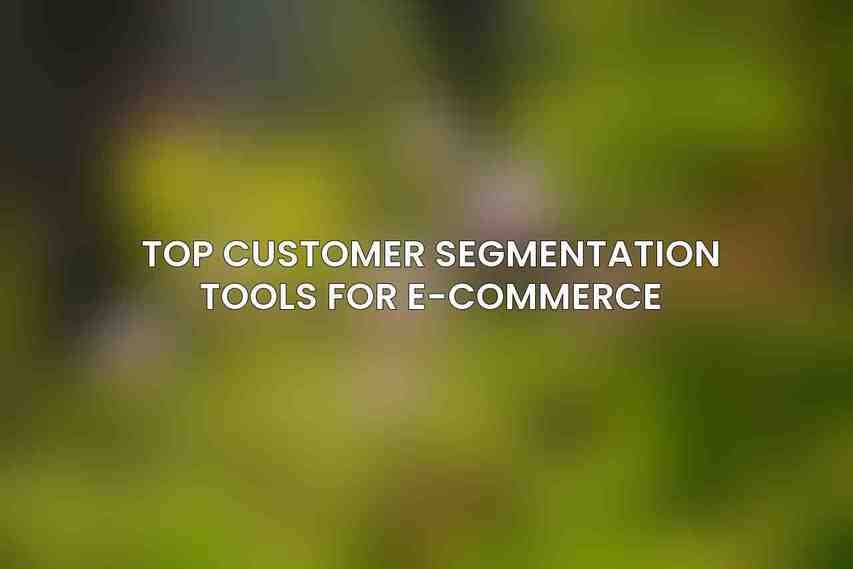Customer segmentation plays a crucial role in the success of e-commerce businesses. By dividing a customer base into groups that share similar characteristics, behaviors, or needs, businesses can better tailor their marketing strategies, products, and services to meet the specific needs of different customer segments. This article will explore the top customer segmentation tools available for e-commerce businesses, discussing their features, pros and cons, and providing recommendations for businesses looking to enhance their segmentation strategies.
Definition and Importance of Customer Segmentation for E-commerce
Customer segmentation is the process of dividing customers into groups based on common characteristics to better target them with personalized marketing messages and offerings. In e-commerce, customer segmentation helps businesses understand their customers’ preferences, behavior, and needs, allowing them to create more targeted and effective marketing campaigns. By segmenting customers, e-commerce businesses can improve customer retention, increase customer satisfaction, and ultimately drive higher sales and revenue.
Types of Customer Segmentation and Their Benefits
There are various types of customer segmentation that e-commerce businesses can utilize, including demographic segmentation, psychographic segmentation, behavioral segmentation, and more. Each type of segmentation provides unique insights into customer behavior and preferences, enabling businesses to create tailored marketing strategies that resonate with specific customer segments. By effectively implementing customer segmentation, e-commerce businesses can enhance customer loyalty, improve customer engagement, and optimize their marketing efforts for better ROI.
Top Customer Segmentation Tools for E-commerce

A. BlueConic
Overview: BlueConic is a cloud-based customer data platform (CDP) known for its robust segmentation capabilities.
Key Features:– Real-time behavioral and transactional data collection- Advanced segmentation engine with pre-built templates and custom rules- Audience builder for creating highly targeted customer segments
Pros:– Comprehensive data integration and segmentation capabilities- Intuitive user interface and easy-to-use segmentation tools
Cons:– Higher cost compared to other tools- Complexity for businesses with limited technical expertise
For more information, visit BlueConic.
B. Segment
Overview: Segment is a CDP focused on customer segmentation and marketing automation.
Key Features:– Data unification from multiple sources into unified customer profiles- Pre-built segmentation models and custom segmentation capabilities- Integrations with popular marketing and CRM tools
Pros:– User-friendly interface and intuitive segmentation tools- Strong integrations and automation capabilities
Cons:– Limited data collection capabilities compared to other CDPs- Costly for small businesses
Explore more about Segment on their website.
C. Iterable
Overview: Iterable is a cross-channel marketing platform with email segmentation capabilities.
Key Features:– Email marketing automation with advanced segmentation options- Audience builder with customizable filters and attributes- Predictive analytics for identifying potential customers
Pros:– Excellent email segmentation capabilities and personalization features- Easy-to-use platform for marketers with limited technical knowledge
Cons:– Limited data collection and segmentation capabilities outside of email marketing- Expensive for businesses needing comprehensive segmentation solutions
Learn more about Iterable at Iterable.
D. Amplitude
Overview: Amplitude is a behavioral analytics platform with segmentation capabilities.
Key Features:– Event-based data collection and analysis for understanding customer behavior- Segmentation based on user attributes, actions, and event sequences- Funnel analysis and cohort analysis for identifying customer behavior patterns
Pros:– Advanced behavioral analytics and segmentation capabilities- Excellent reporting and visualization tools
Cons:– Limited data integration capabilities compared to other CDPs- Complexity for businesses without dedicated analytics expertise
For further details, visit Amplitude.
E. Mixpanel
Overview: Mixpanel is an analytics and engagement platform with segmentation capabilities.
Key Features:– Event-based data collection and analysis for understanding customer behavior- Segmentation based on user attributes, actions, and engagement metrics- Integrations with popular third-party tools and platforms
Pros:– Strong event-based data collection and analytics capabilities- Intuitive user interface and easy-to-use segmentation tools
Cons:– Limited data integration capabilities compared to other CDPs- Expensive for businesses needing comprehensive segmentation solutions
Find more about Mixpanel on their website.
Selection Criteria for Customer Segmentation Tools

When choosing a customer segmentation tool for e-commerce, businesses should consider several key factors:
- Data collection and integration capabilities
- Segmentation options and flexibility
- User interface and ease of use
- Integrations with other marketing and business systems
- Pricing and value for money
By evaluating these criteria, businesses can select the tool that best fits their segmentation needs and budget constraints.
In summary, the top customer segmentation tools for e-commerce offer a range of features and capabilities to help businesses effectively segment their customer base and improve their marketing efforts. When choosing a tool, it is essential to consider factors such as data integration, segmentation options, user interface, integrations, and pricing to find the right fit for your business needs. For businesses looking to enhance their customer segmentation strategies, selecting the right tool can make a significant difference in driving sales and customer satisfaction. Consider the recommendations provided based on your specific business requirements to make an informed decision in implementing customer segmentation tools effectively.
Frequently Asked Questions
What is customer segmentation?
Customer segmentation is the process of dividing customers into groups based on characteristics such as demographics, shopping behavior, and preferences.
Why is customer segmentation important for e-commerce?
Customer segmentation allows e-commerce businesses to better understand their customers, personalize marketing efforts, and improve overall customer experience.
What are some popular customer segmentation tools for e-commerce?
Some popular customer segmentation tools for e-commerce include Salesforce Marketing Cloud, HubSpot CRM, Mailchimp, and Google Analytics.
How do customer segmentation tools help e-commerce businesses?
Customer segmentation tools help e-commerce businesses analyze customer data, create targeted marketing campaigns, and increase customer retention and loyalty.
What factors should be considered when choosing a customer segmentation tool for e-commerce?
When choosing a customer segmentation tool for e-commerce, factors to consider include ease of use, scalability, integration with existing systems, customer support, and cost.
